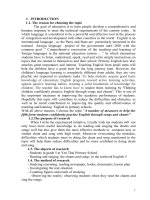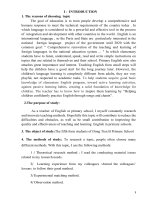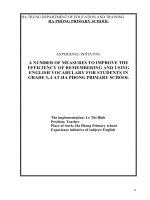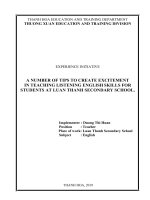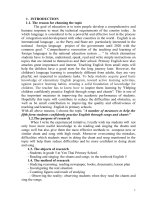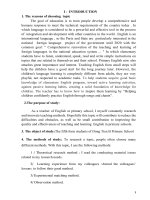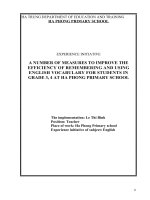(SKKN mới NHẤT) a number of measures to help the fifth form students confidently practise english through songs and chants
Bạn đang xem bản rút gọn của tài liệu. Xem và tải ngay bản đầy đủ của tài liệu tại đây (778.78 KB, 18 trang )
1. INTRODUCTION
1.1. The reason for choosing the topic
The goal of education is to train people develop a comprehensive and
humane response to meet the technical requirements of the country today . In
which language is considered to be a powerful and effective tool in the process
of integration and development with other countries in the world . English is an
international language , so the Party and State are particularly interested in the
national foreign language project of the government until 2020 with the
common goal: " Comprehensive renovation of the teaching and learning of
foreign languages in the national education system ... " In which elementary
students have to listen, understand, speak, read and write simple instructions on
topics that are related to themselves and their school. Primary English now also
attaches great importance and interest. Teaching English from small steps will
help the children have a good start for the long journey later. However, the
children's language learning is completely different from adults, they are very
playful, not respected to academic tasks. To help students acquire good basic
knowledge of elementary English program, toward active learning activities,
against passive learning habits, creating a solid foundation of knowledge for
children. The teacher has to know how to inspire them learning by "Helping
children confidently practice English through songs and chants". This is one of
the important measures in improving the academic performance of students.
Hopefully this topic will contribute to reduce the difficulties and obstacles, as
well as be small contribution to improving the quality and effectiveness of
teaching and learning English in primary schools.
With all above reasons, I choose the topic "A number of measures to help the
fifth form students confidently practise English through songs and chants"
1.2.The purpose of research
When I write the experienced initiative, I really wish my students will not
only have more useful knowledge to do reading and singing the chants and
songs well but also give them the most effective methods to compose new or
similar chant and song with high result. Moreover overcoming the mistakes,
difficulties which students meet in doing the chant and song mentioned in the
topic will help them reduce difficulties and be more confident in doing chant
and song .
1.3. The objects of research
- Students in grade 5 at Yen Thai Primary School.
- Reading and singing the chants and songs in the textbook English 5
1.4. The method of research
- Studying reasoning: reading newspaper, books, documents, lesson plan
- Investigating the real situation
- Counting figures and result of studying
- Observing the reality: observing students when they read the chants and
sing the songs.
1
download by :
- Experimenting the teaching methods
- Summarizing the results, learning from the colleagues’ experiences.
2. THE CONTENT OF THE EXPERIMENTAL INITIATIVE
2.1.The rationale
The views of the Party is to improve foreign language skills for the
majority of the young generation of the country, and propose innovative
solutions to address the pressing issues faced in the rapidly improving language
resources for students. So far English is considered as a subject to be focused
and get a lot of attention at the primary level. To meet the requirements of
national renewal, each teacher must have completed myself teaching career. To
do well the teaching and learning of foreign languages in elementary school , the
teachers must understand clearly the children’s psychology in elementary school
as well as their characteristics and abilities when learning language:
+ Children are very active so that they can not afford to sit obediently and
listen to the teacher's lecture.
+ In addition, children do not have the ability to concentrate for a long time
about 5-10 minutes to think and acquire knowledge. So in the foreign language
classroom, children have been involved in many different learning activities.
+ Children need the repetitive elements. I know that children absorb and
imitate very fast but forget very quick, too. Therefore, materials must be
practised as much as possible. In English classes, the teacher should create
opportunities for the children to further practice through physical exercise (listen
and repeat), replaced exercise. To meet the specific characteristics of children in
the process of learning a foreign language, we have used the techniques and
forms of communicative exercises to facilitate formation of a language learning
environment. Also in these environments where students are exposed more.
Using visual items for children to be exposed to English native speakers through
audio / DVD. Students become active elements of lectures.
+ Children learn through listening, watching, imitating. Children acquire
knowledge in a completely different way from adults. Adults acquire knowledge
in a sense, analysis, young acquire naturally through intuition. So what exercises
to strengthen the observation of children through the audio-visual and
mechanical imitation as well as modeling activities of teachers to introduce the
new materials must ensure the accuracy of the language, especially
pronunciation.
+ The ability of children are curious, energetic and creative in a very natural
way. Children always need to explore their surroundings and interact with
people, so that children establish an understanding of the world children live.
+ Children would love to communicate. When we monitor children talk,
we'll all enjoy the talk, though not as something important. When we meet the
children who we do not know, through the first minute they might be shy, but
after a few questions of our encouragement, they will tell us about their selves,
2
download by :
their parents, interests, including saying bad things that their friends do, and
would love to ask questions back.
With the above characteristics, we can see that, in order to help them get a
better ability to practice languages well, we need to have a reasonable solution.
We can not teach children like to teach an adult. This shows that the teacher
must have a high technical level to enter the world of young children to
eventually lead to new concepts, to a deeper understanding of concepts that
children initially approached. Children learn language depends heavily on
incentives. This totally depends on the style of the teacher. If teachers encourage
young children to create a good learning environment, children will learn a lot
faster. In many teaching methods to promote positive child, there are two
methods which are consistent and favorite for all ages are songs and chants.
There are many English songs for children but there are not many chants.
Consequently, the teacher must know how to combine the use of all available
ones and promote their abilities in self-composing songs and chants so that all
class hours achieve the highest efficiency.
2.2.The real situation before applying the experienced initiative:
Through practical teaching in Yen thai primary school I see, there are some
advantages following:
Administrators are very interested in foreign language teaching. The school
has one teacher of English who always tries to self-learn, self- upgrade her
skills, create and know how to apply the information technology in teaching,
innovate teaching methods appropriate for each kind of students in order to help
them quickly understand the lesson. That is teacher who loves the teaching job,
the kids and who is enthusiastic and responsible in the work, ready to complete
all assigned tasks.
During the past school years, English teachers’ group ensures the quality of
teaching and learning, ends the situation of letting students be in the class which
is not appropriate with their language ability.
On the other hand, it also has a certain number of difficulties:
+ At my school, teaching aids are limited, especially the lack of audiovisual
media to help students develop their listening and speaking skills.
+ There is a number of hard students who are the children of the poor
families or the families in which the parents are divorced...Therefore, the
education of the children in these families are little cared for, which affects the
children’s learning outcomes.
+ And what is equally important is that a lot of parents do not know
English, therefore, it is impossible for them to help their children to learn
English.
+ Some children have psychology of being shy when speaking in the
public.
3
download by :
+ Because of circumstances, many children do not focus on learning
foreign language, they learn how to cope and some are bored with studying
English.
+ They don’t speak English fluently because of no regular use.
*The survey results in early school year of grade 5 Yen Thai Primary
school
Class Total
5A
24
5B
23
Quality
Excellent Percent Good Percent Average Percent Weak
4
16,7 %
7
29,1 %
10
41,7 %
3
3
13,0 %
4
17,5 %
11
47,8 %
5
Percent
12,5 %
21,7 %
So how to help the teaching and learning English achieve high
efficiency? Through teaching and research so I boldly launched "A number of
measures to help the fifth form students confidently practise English
through songs and chants."
2.3.The solutions of implementation.
Through practical teaching in Yen Thai primary school. I have researched
and used the following measures to help students improve their language
learning in primary schools better:
2.3.1. Studying the textbooks:
The purpose of this method is to help the teachers master the English
program of grade 3,4,5 to find the most appropriate method for each particular
lesson.
Currently the school is using the book English of Macmillan education
publisher for grades 3,4,5. Through the book I find that the form of this book is
suitable for primary school age: pictures are colorful and vivid, the characters
are fun and accompany them from the first lesson for the rest of the books, give
them the curiosity through each lesson, help them see the characters as their
friends. In terms of the content of this book revolves around the topic, the topic
is very friendly, close to the lives of the children. Each topic focuses on phonics,
vocabulary and grammar with very short sentence patterns consistent with age.
The structure of all these books meets the aesthetic and content for elementary
school children. As we know, to study well, students need to have a good set of
books and teachers have to know how to use the method correctly and flexibly
to transmit knowledge to the children. On the other hand, due to the
requirements of society and the demands of educational strategies, each teacher
must improve teaching skills that are suitable with school age. It means that
when teaching in the classroom we must take into account that:
4
download by :
+ Children do not have the ability to understand the rules of grammar, do
not understand the explanation of rules of language. Such rules on the use of the
verb.
If we explain that: the present simple used to express repeated daily action,
habits ... it is too abstract, children do not have the ability to imagine the content
of rules to understand, as well as remember sample sentences and grammatical
rules, so they just learn the prefabricated phrases without being analyzed how
to form these sentences.
+ Children have the ability to imitate very quickly what adults do so when
learning new things they will absorb very fast but also be easy to forget.
+ Children enjoyed singing and dancing as they enjoyed participating in
activities not like to sit silently long.
So the teacher in the classroom is only the instructor, the students’ role as a
positive factor, they voluntarily participate in activities that teacher provides in
a natural way, these activities are songs and chants.In the program English of
Macmillan education publisher, the songs also appear in units of lessons with a
more frequency, Each unit of the English of Macmillan education publisher has
three lessons so there are many chants and songs . However, in order to make
students love songs and chants in English lessons, the teacher has to master how
to teach songs and chants, help students learn in the most effective way and
create excitement for the English language. So I boldly launch "A number of
measures to help the fifth form students confidently practise English through
songs and chants" to help children practice well the skills as well as use new
words and modal sentences exactly and smoothly.
2.3.2. Methods of teaching songs and chants for primary students
The purpose of these methods is to create excitement for students, create a
change in class activities, review the vocabulary and sentences, help students
practice the pronunciation, intonation, stress…Besides, they are used to switch
to a new or familiar topic, Specifically as follows:
a. Songs
Most of children, especially the primary students like singing very
much. Through the study of teaching songs as a kind of lively and attractive
exercises in order to teach children how to learn foreign languages. I can give
the benefits of teaching songs in a foreign language class.
+ Help students improve memory , concentration, association .
+ Help bring motivation for them .
+ Help students relax after the stressful study .
+ Help the children get along with other students in the class .
+ Change the status of a classroom effectively, help the English lessons
more interesting, balance energy level in the class.
+ Especially, help students review as well as practice the materials such as
vocabularies, modal sentences, pronunciation and intonation effectively.
5
download by :
Sometimes songs are used to teach new materials.They are really sticky, make
children remember material very well.
However, in order to teach a song successfully, the teacher has to master
the basic steps to teach it:
* The process of teaching a song:
+ Review or introduce the main structure in the song using pictures/
objects when possible.
+ Play the recording, let children hear the whole song once . This step
helps them have a chance to access the melody of songs , create emotion and
curiosity for this tune. This is also a step which creates excitement for the
children so that they are ready to take part in.
+ Let children read the lyrics line by line. At this time, children have to
pronounce exactly the lyrics. They have to particularly pay attention to the
sound of wind because Vietnamese also have negative wind but its position is
not the same in English .
For example, the sound of wind in English appear a lot at the end of many
words such as : Piece / pi : s / , wish / wi∫ / and wind sounds in English is
difficult to pronounce, especially when they stand at the end such as: “chair /
t∫eə /, watch / w סt∫ / , village / vilid / . Students often miss the sound when
singing. This makes our Vietnamese be turned , lack of tonal English .
+ When reading vocabulary, we need drill the children to read the stress
properly ('apple, 'every, 'beautiful) because in English songs, the word stress is
very important. However, the sentence stress doesn’t take any important roles
because it is dominated by songs. When training them to read the lyrics we
should pay attention to interrupt as the way the song breaks, do not interrupt as
the grammartical request. In this way, the children will be able to acsess the
rythym easily.
For example: In the song “What do you do in your free time?” the
following sentence is interrupted as the rythym below:
Hello,my friend, how are you?
What do you do in your free time?
In my free time, I go camping.
I go camping with my friends.
............
So when practising the children to read, the teacher should teach them to
interrupt in this way so that they can sing the song in the correct rythym.
In the process of teaching children to read, the teacher should explain to
children the meaning, content of the song. However the teacher only explains
the common sense without teaching each sample sentences appearing in the
song. We still provide for them corpus in principle as they are prefabricated
units.
For example: When teaching the song “Where will you be ?” we only
teach them know the prepositions go with locations" in the mountains, in the
6
download by :
countryside, at the seaside,at school...." and know how to use prepositions with
locations:
Where will you be next weekend,
In the mountains or the countryside?
I think I'll be in the mountains.
Where will you be tomorrow,
At the seaside or at school?
I think I'll be at the seaside.
Where will you be next year,
In Viet Nam or England?
I think I'll be in England.
+ Let children sing each verse, teacher composes the movements fit the
lyrics. This step children often imitate fast melody and lyrics. Teachers can use
CD or DVD, get the children repeat each sentence. The reason for this
requirement is that the songs in the disk are sung by British, American children.
The intervention of the teacher's voice isn’t often as positively effective as the
young native voices.
+ Open tapes for children to sing along and make movements. When
children have grasped the whole ways to sing each verse, children need to be
connected to sing the complete song. Again CD / DVD gives opportunities for
children to adjust the sound and rythym
+ Have children sing in groups, combining both singing and making
movements.
+ Call on some students to perform before the class.
After finishing teaching a song, the children will be very excited and the
lessons also become more interesting. By the way teaching English through
songs will be easier for the teacher to teach as well as for children to study.
These songs are often used in less controlled practice / Production, warm up or
checking the previous lessons. Along with songs, chants also play an important
role in practising children new words, modal sentences, intonation and stress.
b. Chants
A chant is simply vocabulary spoken over a background of music or
rhythm. They are useful because something about the music energizes the
students, and they have to pronounce the word in a rhythm. I found that a chant
is a lot easier to teach than a song. However, I also use chants often in my
regular weekly classes. Also, if you are not comfortable with singing in front of
your students, chants are useful.
In the process of learning a foreign language, we have used the nature of
this type of chant to train the students ability to speak English correctly with the
7
download by :
sentence stress and sentence rhythm as well as remind students the grammar that
they were learned as sample sentences, vocabulary... Teach students the
language functions such as explanation, asking for information, developing
listening and speaking skills, creating a fun atmosphere in the classroom
appealing to help students learn to speak a foreign language easier. The chants
are all constructed on the basis of common everyday words, not poetry. Rhythm,
stress and intonation of the chant is a version of a natural language, a word of
those who have studied in.. For example, when we read the chant “How do you
learn English?" How do you practising speaking ? By speaking English every
day. How do you practise reading?By reading comic books..... (chant) our
reading must be the same as the words saying in the society, although it echoes
the rhythm of poetry. Chant for foreign language classes often serve the purpose
of teaching, grammar (sample sentence), pronunciation (stress, rhythm sentence,
consonant - vowel sounds). We call these kinds of chants as Vocabulary,
Grammar chants or Phonics chants.To help the students study well, the teachers
must master the process of teaching a chant:
* The process of teaching a chant:
- Have students listen to the teacher read the form once, the teacher says
while clapping to the beat all. Have students read new words. Teachers explain
the meaning of new words using pictures and illustrative movements without
translation into Vietnamese. Speaking content chant, teachers just explain to
children of all common sense chant, through images, gestures, situations. Not
taught phrases appear in all chants. We offer corpus for children in principle as
they are prefabricated units.
- Teaching reading the post chants. Teachers copied chants on the board
then marked * or underlined sentence stress for students to read properly. Read
each statement of post chant and clap in accordance with the accent and rhythm
of each sentence. Note repeatedly until drill their students to memorize. Teach
student the movement in post chant.
- Divide the class into two groups. A group repeats each sentence of the
chant while other claps their hands in the correct rythym of the chant then switch
roles to do the steps above.
- Call a student reread chants.
- The class read the chant again to review the entire phonics of the chant
* For example : Teaching a chant to practice the phrases and words in the
English 5 –Unit 8: What are you reading? – Lesson 3 (part 3) Let's chant.
- Teacher shows some pictures and posts or writes the chant on the board
8
download by :
What are you reading?
What are you reading?
I’m reading the Aladdin story.
What’s Aladdin like?
What’s he like?
He’s clever and he’s kind.
What are you reading?
I’m reading the Cinderella story
.
What’s Cinderella like?
What’s she like?
She’s beautiful and she’s kind.
+ Listen though: Let students listen to the teacher reading the chant a few
times to create the impression of rhythm.
+ Teaching the meaning: Explain the main ideal of the whole chant, not
translate each sentence. Have pupils read the chant and check comprehension.
- Play the recording all the way through for the class to listen and follow in
their books. Play it again for them to do choral and individual repetition. Show
pupils how to chant and do actions. Devide the class into two groups: one group
says the questions and the other says the answers. Invide two groups of four to
the front of the class to chant. The rest of the class claps their hands.
2.3.3. Composing and guiding students to compose songs and chants:
a. Songs
In the book English 5 there is one song per each unit and one chants so the
teachers change songs and chants matching the theme of the lesson. But there
are too many English songs so sometimes it seems difficult for the teachers to
find a suitable song for their class. The appropriate requires here involve many
aspects: suitable for ages, suitable for the topics that they learning, suitable for
to the ability to acquire, and suitable for children’s understanding. Sometimes
we find a good song which is suitable with the theme but its rythym is very
difficult for the children to imitate.
To solve the above proble, the teacher must know how to compose a song at the
request of her. However, it’s impossible for teachers to compose the rythym of
the songs because they are not musicians and do not understand the basic music.
So teachers can use the melody of the songs that are familiar with the children,
or the songs are taken from English books for primary students or the songs in
the course of their own and then compose the new lysics. However, to do these
the songwriting, the teacher needs to master the following steps:
+ Step1: Select the samlpe songs (with interesting melody but also easy to
remember)
9
download by :
+ Step 2: Select the topic, theme matching the content that the teachers are
teaching or teachers need to review.
+ Step 3: Find words related to the topic chosen for replacement (to do this
step students have to find the words that are suitable for both content and
number of syllables
+ Step 4: Merge the selected words in the lyrics to make a new song as the
topics that teachers select.
* For example: To practice Ss the model sentence: “What’s the matter
with you ?” and the vocabularies about the topic “ What's the matter with you ?”
in Unit 11 English 5 I have done the following:
+ Step1: Choose the song “What's the matter with you? ” for model. This
is an interesting song with familiar melody.
What's the matter with you?
Come on,get up.get out of bed.
It's time to go to school.
I'm sorry,Mum, I don't feel well.
I have a headache and a fever,too.
What's wrong? What's wrong?
What's the matter with you?
I'm sorry, Mum. I don't feel well.
I have a toothache and a sore throat,too.
(Teachers presents the song -> Let the Ss listen carefully to recognize the
melody of the song)
+ Step 2: Provide training requirements for students is learning phrases
"What's the matter wiyh you?" And the topic of vocabulary is "Physical states"
+ Step 3: Find the related topic to replace such as "sick, OK, hot, tired,
stomach ache, earache, sore eyes ....."
+ Step 4: Merge the selected word into the lyrics of a song to create new
song
For the teacher’s composing gets good effectiveness, the teacher also
guides students how to compose songs in order to promote the knowledge they
have learned. Teacher brings the topics for the students to discuss and they
compose the songs for themselves. That's the next extremely important step for
them to practice language effectively.
* Drill:Basing on the steps of composing a song and the sample song
above. Teacher gives a topic,some modal sentences and vocabularies, then asks
Ss to make new lyrics with this melody.
* Here are some students’new lyrics :
10
download by :
+ 1st song : Topic “ How do you learn English ?”
How do you learn English ?
How do you learn English?
How do you practise speaking?
I speak to my friends every day.
How do you practise reading?
I read English comic books.
How do you practise writing?
I write emails to my friends.
And how do you practise listening?
I watch English cartoons on TV.
(speak English everyday, read short story,.....)
+ 2nd song: Topis “The weather song”
The weather song
What's the weather like?
What's the weather like?
What's the weather like today?
It's sunny and it's windy.
And there be rain later.
What will the weather be like?
What will the weather be liike?
What will the weather be like
tomorrow?
It will be cold. It will be wet.
And there will be snow as well.
Example 2: To train the students some phrases describing daily activities
in "Unit 2: I always get up early. How about you? the teacher guides students
to use the melody of the song “ This is the way we do things” and replace these
phrases into it to make new lyrics .
+Teacher presents the song “ This is the way we do things” :
+ Students make new lyrics
This is the way we brush our teeth,
Brush our teeth, brush our teeth.
This is the way we brush our teeth,
11
download by :
So early in the morning
This is the way we wash our face,
Wash our face, wash our face.
This is the way we wash our face,
So early in the morning.
This is the way we eat our food,
Eat our food, eat our food.
This is the way we eat our food,
So early in the morning.
(New lyrics)
This is the way we go to school,
Go to school, go to school.
This is the way we go to school,
So early in the morning.....
+ And other similar phrases can be replaced such as: “dress ourselves,
comb our hair, carry our books…”
Example 3: Teachers can take any songs in the textbooks and asks them to
compose new lyrics as the topic that the teacher requires.
For example, basing on the song "What did you do at the zoo?" in the unit 9 of
English 5 students write more new lyrics about animals.......Here is the
students’lyrics that is composed basing on the sample song "What did you do at
the zoo?"
What did you see at the zoo ?
Where did you go yesterday?
I went to the zoo.
Who did you go with?
I went with my friend Sue.
What did you see at the zoo?
We saw some peacocks.
They were very beautiful.
And we saw some kangaroos.
They were fast and funny,too.
Similarly, Ss can sing a lot of songs by replacing suitable words in above
sample
Through this part of composing songs I realize that students are really
proactive and creative in the use of vocabulary, they can improve their
vocabulary significantly, and especially remember phrases well. One little more
methods that students need to do similarly is Chants
12
download by :
b. Chants
I know children would love to read poetry and singing. So that teachers
can avoid boring atmosphere when teaching children to learn words, phrases and
pronunciations by using the above chants. However, sometimes it is not easy
for the teacher to find out the suitable chants with the requirement that the
teacher is teaching. For example, there are words that we need to teach for
Vietnamese children such as “Chopsticks”, or difficult English sounds that
Vietnamese Ss often make mistakes such as / s /, / ∫ /, / t∫ /, / δ /,/θ/ are difficult
to find in the chants used to teach for the Western children. So the challenge for
teacher is to build himself/herself an ability of making chants. Besides, an other
reason is that we could not find many but could find only some chants with a
theme, a sample sentence . Capacity of making chants helps teachers enhance
the number of chants in a topic, for a purpose. The method is mainly based on an
available chant and change its elements according to their own. But the most
important thing while composing chants is to keep the beat of the original chant.
To ensure this we need to note about the number of sounds ( not words
because in English, there may be one or more sounds in each word).
->There is many chants in the book English 5 so the teacher encourage pupils to
make the same chants for the Ss to practice.
For example: The teachers can change its elements according to their own.
Original sentences
Where do you live?
Where do you live?
I live in Quang Trung Street.
Where do you live?
I live in Green Avenue.
Where do you live?
I live in Green Tower.
What's Green Tower like?
It's tall and quiet.
What's your flat like?
It's big and pretty.
Compositions
Where do you live?
Where do you live?
I live in Thanh Hoa Province.
Where do you live?
I live in Yen Dinh District.
Where do you live?
I live in FLC Tower.
What's FLC Tower like?
It's modern and beautiful.
What's your house like?
It's large and comfortable.
So from an original chants teachers themselves can compose a similar
chants with slowly and humming rythym of reading that makes students very
easy to remember.
For the teacher’s composing gets good effectiveness, the teacher also guides
students how to compose chants in order to improve the knowledge they have
learned. Teacher brings the topics for the students to discuss and they compose
the chants for themselves. That's the next extremely important step
for them to practice language effectively.
13
download by :
*Here are some chants that the students compose basing on the teacher’s
“original sentences”.
+ 1st chant: Topic “ What do you do in the morning ?”:
Original sentences
What do you do in the morning ?
I always brush my teeth.
What do you do after getting up?
I usually go to school.
How often do you go to the library?
I go there once a week.
How often do you play computer
games?
I play them every week!
Compositions
What do you do in the evening ?
I always do my homework.
What do you do before going bed?
I usually drink a glass of milk.
How often do you go to the zoo?
I go there twice a year.
How often do you play hide-andseek?
I play it every school day!
+ 2nd chant: Topic: “Where will you be this weekend ?”
Original sentences
Where will you be this weekend?
I think I'll be in the country side.
What will you do there?
I think I'll have a picnic.
Compositions
Where will you be next weekend ?
I think I'll be in Ha Noi Capital.
What will you do there?
I think I'll visit Thu Le Zoo.
Where will you be next weekend?
I think we'll be at the seaside.
What will you do there?
I think we'll visit the islands.
Where will you be next summer?
I think we'll be at Ha Long Bay.
What will you do there?
I think we'll explore the caves.
+ 3rd chant: Topic: “ What's the matter with you ?”
Original sentences
What's the matter with you ?
I have a toothache.
You should go to the dentist.
You shouldn't eat a lot of sweets.
Compositions
What's the matter with you ?
I have a backache.
You should go to the doctor.
You shouldn't carry heavy things.
What's the matter with you?
I have a headache.
You should go to the doctor.
You shouldn't watch too much TV.
What's the matter with you?
I have a stomach ache.
You should go to the doctor.
You shouldn't drink cold water..
14
download by :
There are many chants that the students compose are very funny. However
they have known how to compose chants by themselves, this helps them develop
language as well as be interested in the subject alot.
Through the application and composing chants and songs in the lesson in
English classes I see a lot more efficient than the conventional practice, the
children participate actively and lively in lessons, they self-promote the
independence of their creativity in composing songs, chants and express
themselves through their work. The songs, chants are searched online and
composed thematic requirements in accordance with their young age. This
measure helps them not boring in English classes. This initiative also requires
the flexibility of teachers in the use of teaching methods.
2.3.4.The effect of the experienced initiative:
Thanks to the combination of teaching methods and the organizational
form of teaching, especially the type of teaching that students are center
maximizes the capacity of each student. So their ability to learn English is very
good. The children learn English with a passion, excitement.
* In the class, the majority of students participate in group activities, and
build up the lessons excitedly.
* They read and speak English more naturally, they know how to use
rising and falling intonation as well as to interrupt and break better than they
used to before
* Through songs and chants,they are practised four basic skills: listening,
speaking, reading, writing effectively
* They are more fearless and self-confident in communication, dare to
show their opinions before the crowd
* Through the application songs and chants as well as teaching them how
to compose songs in the process of teaching English for the students at Yen
Thai primary school, I see a visible change in learning attitude of students in
English classes. Students are eager to prepare the lessons before class so that
the quality of English has improved markedly.
The survey by the end of March 2018
Class Total
5A
24
5B
23
Quality
Excellent Percent Good Percent Average Percent Weak
10
41,7 %
9
37,5 %
5
20,8 %
0
7
30,4%
10
43,5 %
6
26,1 %
0
Percent
0
0
Looking at the statistics as a teacher I believe that: Measures to help
students improve their ability to practice English through songs and chants, will
help students develop the best language learning ability of themselves as well as
raising the level of teachers who always try their best to find the best methods
for teaching their students.
15
download by :
3. CONCLUSION AND SUGGESTIONS
3.1. Conclusion
Through research and application topics: “Several measures to help
students of grade 5 improve their ability to practice English through songs and
chants”. I've learnt some lessons.
To improve the quality of teaching, the teacher must be dedicated to her craft,
take responsibility for their lessons, take care of all students in the class and the
quality of teaching to find flexible approaches towards experience initiative in
line with her students.
- Prepare lesson plans thoughtfully, meticulously. Increase use of available
or homemade teaching aids practically and effectively.
- Using methods of teaching flexiblly in English lessons, especially using
songs or chants that are available, composed or collected, combining with
organizing games to enhance vocabulary and practice modal sentences in order
to give students a keen subject. Consolidate for Students simple centre
knowledge which is easy to remember, easy to use.
- Encourage students to speak English more regularly in the class.
- Reward frequently gifted students who have progress and participation in
building lessons. In addition, regularly help and encourage the students who are
weak and immediately correct their mistakes of the foreign language gently, so
they are not guilt, shame, fear of failure leads to afraid to say or lazy learning.
With much effort, the heart of enthusiasm for the job, and I'm always
striving to find new ways of teaching to engage students and help them love
English language, learning English much better. Above is amount of little
experience that I have done and achieved positive results during the last
teaching.
3.2. Suggestions
To improve the quality of teaching and learning of English in primary
school I have some suggestions to management:
+ Request more on providing audiovisual equipment for effective school
+ Request more information on the subjects of English language for
teachers have more conditions to learn from each other
+ Suggest superior rooms to facilitate the teaching and learning of foreign
languages, audiovisual room and multimedia classrooms.
Above are some of the content and methods that I have drawn from actual
teaching of myself in teaching and learning in Yen Thai Primary School. But
there are still certain restrictions so I look forward to the comments of
colleagues and superiors’comments to the subject for more complete days.
Thank you for the attention!
16
download by :
CONFIRMING OF THE HEADMASTER
Yen Dinh, April 10th 2018
I assure that this is my experience
initiative. I do not copy other
people’s content.
(Sign and write the full name)
Trinh Thi Cuc
17
download by :
References
TT
1
2
3
4
5
6
7
Tên tài liệu
Sổ tay người dạy tiếng Anh
Phương pháp dạy tiếng Anh
trong trường phổ thông
Phương pháp dạy tiếng Anh
tiểu học
Teach English.
Nguồn tài liệu
nhiều tác giả
Nguyễn Hạnh Dung
Websites:
Internet
Ghi chú
Nguyễn Quốc Hùng
Cambridge University
Press
Teach young learners English Nguyen Quoc Hung,
MA
English
5(
Macmillan Nhà xuất bản giáo dục
Education)
Việt Nam
http://
www.englishvideolesson.com/
arama.php?arama=chants
o/kidsongs/
18
download by :

